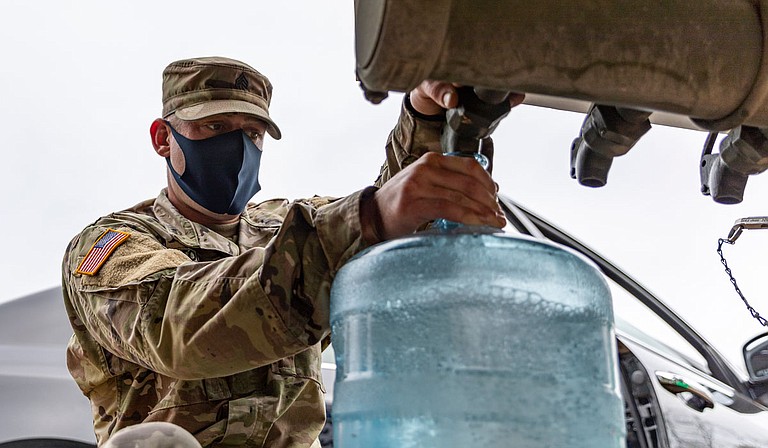As March arrived, Mississippi National Guard members were supplying nonpotable water to Jackson residents. U.S. Army National Guard Photo by Sgt. Jovi Prevot
Wednesday, March 3, 2021
Parts of Jackson were still without water two weeks after the February winter storm wreaked havoc on the capital city's two water-treatment plants. As March dawned, city leaders were continuing efforts to provide portable and nonportable water to residents who needed it, with the Mississippi National Guard's assistance.
Mayor Chokwe Lumumba and Public Works Director Charles Williams appeared Feb. 28 at the O.B. Curtis Water Treatment Plant in Ridgeland, acknowledging that they could not predict when everyone will be able to get water in the city.
"What we have faced and what we have seen as a result of the winter storm (is that) water-treatment facilities are not meant to shut down to the level that we experienced," the mayor explained.
"Because they weren't meant to shut down in that way, the process of getting it moving back to where it was prior to the storm is a difficult recovery process, and so it's not simply as easy of a proposition of turning on a switch."
"So while we can't give you a precise day and hour in which that water will come on, what we're confident in is that they are working the system as it should be."
Williams went into specific detail at the press briefing. From a low of 37 pound per square inch of pressure amid the winter storm—more than 50 points too low—the public-works department has struggled to increase the treatment plants' pressure to the level needed to supply water for the entire city, especially those at higher elevations.
They decided to open fire hydrants that dot the city to relieve the air pressure built into the system blocking water flow, and on Feb. 21, the public works director said the psi is at 90psi, but the problem is maintaining that level.
"One of the biggest efforts that we were trying to accomplish yesterday (Feb. 27) was we were going along different corridors—Terry Road, Raymond Road and McDowell Road—and opened up fire hydrants," Williams said. "And the reason for that is a lot of times when you lose system pressure, a lot of air gets in the line."
"And so as we're trying to push more water out into the system, we wanted to take some of that air off. And the benefit of it was today (Sunday) we started seeing more water circulating now in south Jackson," one of the hardest-hit parts of the city because of its distance from the treatment plants.
Williams compared the experience to the crash of a computer. He acknowledged that restoring the correct function has been slow and showed on a map that reservoirs are all over the city, and were depleted when the water treatment centers suffered the winter blast effects.
"As you see the storage tanks that are throughout the city of Jackson, we are trying to gain enough pressure to get these storage tanks filled," Williams said.
"We are also trying to get water from (O.B. Curtis Water Treatment Plant and from) J. H. Fewell (Water Treatment Plant). We are trying to get water from these two particular plants and get it all the way down into the system."
The public-works director said the system needs 90psi consistently to get the water down to the people farthest from the plants in west and south Jackson. Due to the complexity of the system, he said they had yet to succeed in that.
"It is built (on) hydraulics, and if you're at a higher elevated area (like) Fondren or if you were in south Jackson, those higher elevated areas, that's why you need a certain pressure in order to get up to those areas, and also push that water down to south Jackson and into Byram."
State, Federal Help Needed
Mayor Lumumba explained that age and lack of weatherization are taking a serious toll on Jackson's water system, and the solution is substantial state and federal aid.
"We're thankful for the tanks that help provide the non-potable water to people, but we need long-term support to deal with this issue that has gone without being addressed sufficiently for decades."
He said the city's annual resources of "a little over $300 million" leave no room for adequately resolving the legacy-city infrastructure needs and protect water treatment plants against extreme weather, which he puts at $2 billion.
The next day, as national media coverage over Jackson's crisis increased, Lt. Gov. Delbert Hosemann said that the City had not asked the State for significant help to address the water crisis and did not indicate that he or other state leaders had reached out to offer help to their capital city.
"I've received no contact from the city at all. No, I have not," Hosemann told the Mississippi Free Press. He confirmed that he had not spoken with Gov. Tate Reeves about his suggestion that the State take over Jackson's water system.
"I haven't talked to the governor about that, either," the northeast Jackson resident added. "Neither the governor nor the city have contacted us at all about any of that."
Hosemann also blamed city leaders since the last white mayor, Kane Ditto, for doing too little on infrastructure in the city. "You remember during Kane Ditto's administration, he did repair work on water and sewer. So what happened since then?" Hosemann said.
Former Mayor Harvey Johnson Jr., the city's first Black mayor who defeated Ditto, responded with facts. "During my administration we spent over $200 million on water and sewer infrastructure improvements over 12 years," he told the Mississippi Free Press. "In my administration we put up two new water storage tanks ... we came from under an EPA-imposed consent decree on our oldest water treatment plant where it was discharging into the Pearl River. We were able to direct that. It cost $10 million to $12 million (just) to do that."
Boil-water Notice Remains
Until all areas get water, the public-works director said his department will not focus on lifting the boil-water notice in effect for the whole city since Feb. 23 because of high turbidity levels, which can interfere with disinfection and provide a medium for microbial growth.
"A water sample taken today, February 23, 2021, showed turbidity levels greater than 1.0 turbidity units. This is above the standard of 0.30 turbidity units. Because of these high levels of turbidity, there is an increased chance that the water may contain disease-causing organisms," the notice stated. Those who have water should not drink it without boiling it first for one minute and letting it cool before drinking, making ice, brushing teeth, washing dishes, and food preparation.
"There's a large 48-inch (water pipe) that comes around Interstate-220, and then there's a 24(-inch water pipe) that comes down on the east side (of the city). And then there are large distribution lines that are 12 (inches) and 16 (inches) that migrate through the city. So as long as we continue to push water through the system, our residents are getting water," Williams said with an air of optimism.
However, water main breaks developed in the wake of the winter storm and pressure builds in the system as the psi increases. The works director said the people should call in when they observe them.
On March 1, Williams announced that the water system had 84 psi, down from 90 psi that he announced on Sunday. "We are pushing out over 50 (million gallons per day) out into the system," the public-works director added.
Williams said that he is already seeing the benefits of opening the fire hydrants to release the air pressure in the system.
"But we're still heavily concerned about our residents who are in south Jackson and those members who live off Forest Hill Road, who continue to suffer, residents who are in Brookleigh Drive, who continue to suffer," he added. "And then other little pockets throughout the city, those residents who continue to suffer without water, and we're working as hard as we can in order to get it restored."
Forest Hill and Brookleigh Roads are higher-elevated areas, including a portion of Byram. "The plants were designed to push water from O.B.Curtis at the reservoir to those areas and down south. And in order for you to achieve that, you need to be consistent with that pressure around 90 psi in order to get that water to those elevated areas (and) that have been a struggle for us for the past week."
Along with restoring the water system, water main breaks continue to happen, with three crews repairing them as fast as possible, Williams said. He said "vendors" are assisting at the water treatment plants and his team is handling the water main break repairs, and rejected the call to involve contractors. Ward 3 Councilman Kenneth Stokes suggested on Feb. 24 that the city needed to have brought in contractors in the height of the water crisis.
"We have roughly had 80 calls for breaks that have come through; (we) have repaired roughly around 50 of those," WIlliams said. "There's still the business community that is struggling when you look at some areas, you know, at Fondren, and even in those areas in south Jackson. Those areas that are higher elevated, they're still having some struggles with having a consistent water pressure."
Bill Adjustments Available
The mayor said on March 1 that residents can submit documentation for bill adjustment if they made repairs to pipes because of problems associated with the winter weather. "Bring a copy of your plumber receipt, or receipt for parts purchased at an appliance counter to the (Water Sewer Business Administration. One of our customer service representatives will be happy to assist. You can also call 601-960-2000," he said.
Lumumba said that because the 311 call line is overwhelmed, the people can leave voice messages on the call stating their full name, phone number, address, and situation. Other available numbers are 601-960-1111 or 601-960-1778.
Williams said the crux of the matter was not that there was a winter storm but how long it lasted. "And when we started getting cold weather that Monday, which was President's Day (Feb. 15). And we got into Tuesday, you know, we didn't really expect another storm to come in after Wednesday, (but) that's what happened," the public-works director added.
"So you look at consecutive days of being around 20 degrees and 25 degrees, our systems were not designed for that, especially those elements that are exposed at the plant," Williams continued.
"And so, as a result of that, we were limited in the amount of water that we can bring into the plant and ultimately the amount of water that we could treat and put into the distribution system."
The mayor pushed back against suggestions that city workers cannot bring the problem under control by reiterating the event's novelty.
"Our system was never meant to be shut down and the way that it shut down, and so when it is shut down like that, the storage tanks are depleted when consumption is high, and then we have to fill up the entire city again," he said. "That is not what a public works department or a water treatment facility is faced with (regularly)."
"But when the production of water into our distribution system is depleted to this level, (what) it takes is time," he added. "They're doing what it takes, (they) have a grip on what needs to be done; it's just a matter of the time that it takes for all of that to fill back up."
Email story tips to city/county reporter Kayode Crown at [email protected]. Follow him on Twitter at @kayodecrown.


Comments
Use the comment form below to begin a discussion about this content.
Sign in to comment
Or login with:
OpenID